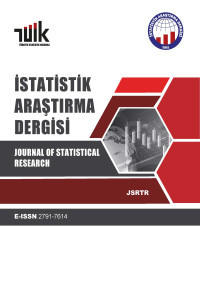Açık Veri ve Coğrafi Bilgi Sistemleri Kullanarak Türkiye için Sürdürülebilir Kalkınma Göstergeleri Tahmini
Coğrafi Bilgi Sistemleri, Kamusal Açık Alan, Kentsel Sürdürülebilirlik, Sürdürülebilir Kalkınma Amaçları, Toplu Taşıma, Türkiye
Estimating Sustainable Development Indicators Using Open Data and Geographic Information Systems for Turkey
Geographic Information Systems, Open Public Space, Public Transportation, Sustainable Development Goals, Turkey, Urban Sustainability,
___
- Almanya İstatistik Ofisi (2018). https://sdg-indikatoren.de/en/11-7-1/ adresinden alındı
- Almanya İstatistik Ofisi (2020). https://sdg-indikatoren.de/en/11-2-1/ adresinden alındı
- Birleşik Krallık SKA (2019). https://sdgdata.gov.uk/11-7-1/ adresinden alındı
- Blaschke, T., & Kovács-Győri, A. (2020). Earth Observation to Substantiate the Sustainable Development Goal 11: Practical Considerations and Experinces from Austria. The International Archives of the Photogrammetry, Remote Sensing and Spatial Information Sciences, Volume XLIII-B4-2020, 2020XXIV ISPRS Congress.
- Brussel, M., Zuidgeest, M., Pfeffer, K., & Maarseveen, M. v. (2019). Access or Accessibility? A Critique of the Urban Transport SDG Indicator. ISPRS International Journal of Geo-Information 8, 67.
- Corbane, C., Florczyk, A., Pesaresi, M., Politis, P., & Syrris, V. (2018). GHS built-up grid, derived from Landsat, multitemporal (1975-1990-2000-2014). R2018A. European Commission, Joint Research Centre (JRC), doi: 10.2905/jrc-ghsl-10007 PID: http://data.europa.eu/89h/jrc-ghsl-10007.
- Çetin, M. (2015). Using GIS analysis to assess urban green space in terms of accessibility: Case study in Kutahya. , International Journal of Sustainable Development & World Ecology Vol.22, No.5, 420-424.
- Danimarka İstatistik Kurumu (2019). https://www.dst.dk/en/Statistik/Sdg/11-baeredygtige-byer-og-lokalsamfund/delmaal-02/indikator-1 adresinden alındı
- Danimarka İstatistik Kurumu (2020). https://www.dst.dk/en/Statistik/Sdg/11-baeredygtige-byer-og-lokalsamfund/delmaal-07/indikator-1 adresinden alındı
- Demircan, N., & Sezen, I. (2018). Use of Green Spaces for Liveable and Sustainable Cities; Urban Allotment Gardens. Iğdır Üni. Fen Bilimleri Enst. Der. / Iğdır Univ. J. Inst. Sci. & Tech. 8(1), 263-270.
- Eurostat (2018). Methodological Manual on Territorial Typologies .
- Kharrazi, A., Qin, H., & Zhang, Y. (2016). Urban Big Data and Sustainable Development Goals: Challenges and Opportunities. Sustainability 8(12), 1293, DOI:10.3390/su8121293.
- Klopp, J. M., & Petretta, D. L. (2017). The urban sustainable development goal: Indicators, complexity and the politics of measuring cities. Cities 63 (2017), 92-97.
- Koch, F., & Krellenberg, K. (2018). How to Contextualize SDG 11? Looking at Indicators for Sustainable Urban Development in Germany. International Journal of Geo-Information 7, 464.
- Murray, A. T., Davis, R., Stimson, R., & Ferreira, L. (1998). Public Transportation Access. Transpn Res.-D, Vol. 3, No. 5, 319-328.
- Norveç İstatistik Kurumu (2018). https://www.ssb.no/sdg-en adresinden alındı
- Norveç İstatistik Kurumu (2019). https://www.ssb.no/sdg-en adresinden alındı
- OpenStreetMap contributors (2020). Türkiye verisi https://geofabrik.de adresinden indirildi. . https://www.openstreetmap.org adresinden alındı
- Permai, S., Mukhaiyar, U., Satyaning, N., Soleh, M., & Aini, Q. (2018). Spatial weighting approach in numerical method for disaggregation of MDGs indicators. IOP Conf. Series: Materials Science and Engineering 332 (2018) 012049.
- Peşkircioğlu, N. (2016). 2030 Sürdürülebilir Kalkınma Hedefleri: Küresel Verimlilik Hareketine Doğru. Anahtar Dergisi, Kasım 2016.
- Sachs, D. (2012). From Millennium Development Goals to Sustainable Development Goals. Lancet, 2012; 379:2206–11.
- Tiwari, G., & Philip, C. (2021). Development of public transport systems in small cities: A roadmap for achieving sustainable development goal indicator 11.2. IATSS Research 45 (2021) 31–38.
- TUCBS Ulusal Coğrafi Bilgi Platformu (2021, 09 10). ATLAS: https://atlas.gov.tr adresinden alındı
- TÜİK (2021). Sürdürülebilir Kalkınma Göstergeleri 2010-2019 Haber Bülteni, https://sdg.tuik.gov.tr.
- UN-Habitat (2021). United Nations Human Settlements Programme SDG11.7.1 Metadata, https://unstats.un.org/sdgs/metadata/files/Metadata-11-07-01.pdf.
- UN-Habitat (2021). United Nations Human Settlements Programme SDG 11.2.1 Metadata,https://unstats.un.org/ sdgs/metadata/files/Metadata-11-02-01.pdf.
- United Nations (2015). Transforming Our World: The 2030 Agenda for Sustainable Development.
- UN-WCED (1987). Report of the World Commission on Environment and Development: Our Common Future. https://sustainabledevelopment.un.org/content/documents/21252030%20Agenda%20for%20Sustainable%20Development%20web.pdf .
- Wang, P., Huang, C., Brown de Colstoun, E. C., Tilton, J. C., & Tan, B. (2017). Documentation for the global human built-up and settlement extent (HBASE) dataset from Landsat. Palisades, NY: NASA Socioeconomic Data and Applications Center (SEDAC), doi: https://doi. org/10.7927/H4DN434S.
- Xiang, N. (2017). A Review on the research and practice of city sustainable development indicators and indices. IOP Conf. Series: Earth and Environmental Science, 88 (2017) 012024.
- Yeni, O. (2014). Sürdürülebilirlik ve Sürdürülebilir Kalkınma: Bir Yazın Taraması. Gazi Üniversitesi İktisadi ve İdari Bilimler Fakültesi Dergisi 16/3, 181-208.
- ISSN: 1303-6319
- Başlangıç: 2002
- Yayıncı: TÜİK
Doğrusal ve Doğrusal Olmayan Birim Kök Testlerinin Gecikme Uzunluğuna Olan Duyarlılığı
Gelir Düzeyinin Hanehalkı Sera Gazı Emisyonlarına Etkisi: Türkiye için Bir Vaka Çalışması
Ersin ERCAN, Mehmet Mustafa YATARKALKMAZ, Onur Fatih BULUT
Selin TEKİN, Birkan ERGÜÇ, Serdar ÖZ
Osman SERT, Alpaslan AKÇORAOĞLU
Cinsiyete Dayalı Ücret Ayrımcılığının ISCO Meslek Gruplarına Göre Analizi
